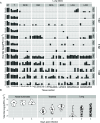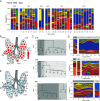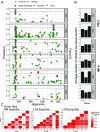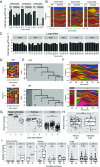Dispersal of influenza virus populations within the respiratory tract shapes their evolutionary potential
- PMID: 39835898
- PMCID: PMC11789087
- DOI: 10.1073/pnas.2419985122
Dispersal of influenza virus populations within the respiratory tract shapes their evolutionary potential
Abstract
Viral infections are characterized by dispersal from an initial site to secondary locations within the host. How the resultant spatial heterogeneity shapes within-host genetic diversity and viral evolutionary pathways is poorly understood. Here, we show that virus dispersal within and between the nasal cavity and trachea maintains diversity and is therefore conducive to adaptive evolution, whereas dispersal to the lungs gives rise to population heterogeneity. We infected ferrets either intranasally or by aerosol with a barcoded influenza A/California/07/2009 (H1N1) virus. At 1, 2, or 4 days postinfection, dispersal was assessed by collecting 52 samples from throughout the respiratory tract of each animal. Irrespective of inoculation route, barcode compositions across the nasal turbinates and trachea were similar and highly diverse, revealing little constraint on the establishment of infection in the nasal cavity and descent through the trachea. Conversely, infection of the lungs produced genetically distinct viral populations. Lung populations were pauci-clonal, suggesting that each seeded location received relatively few viral genotypes. While aerosol inoculation gave distinct populations at every lung site sampled, within-host dispersal after intranasal inoculation produced larger patches, indicative of local expansion following seeding of the lungs. Throughout the respiratory tract, barcode diversity declined over time, but new diversity was generated through mutation. De novo variants were often unique to a given location, indicating that localized replication following dispersal resulted in population divergence. In summary, dispersal within the respiratory tract operates differently between regions and contributes to the potential for viral evolution to proceed independently in multiple within-host subpopulations.
Keywords: dispersal; evolution; influenza virus.
Conflict of interest statement
Competing interests statement:The authors declare no competing interest.
Figures







References
-
- Zwart M. P., Elena S. F., Matters of size: Genetic bottlenecks in virus infection and their potential impact on evolution. Annu. Rev. Virol. 2, 161–179 (2015). - PubMed
MeSH terms
Grants and funding
LinkOut - more resources
Full Text Sources

